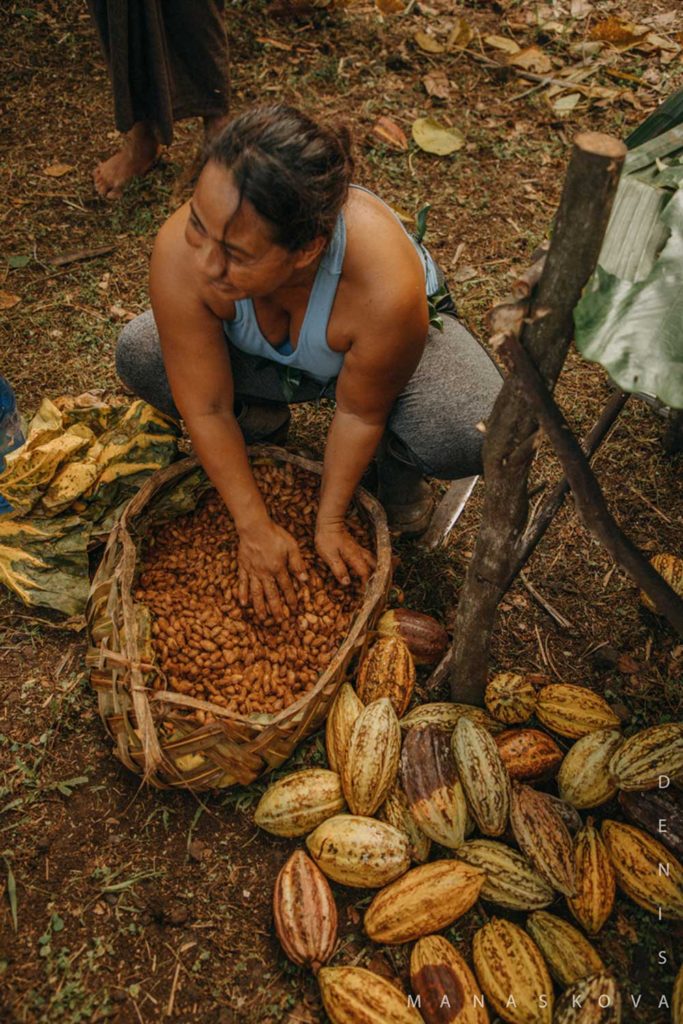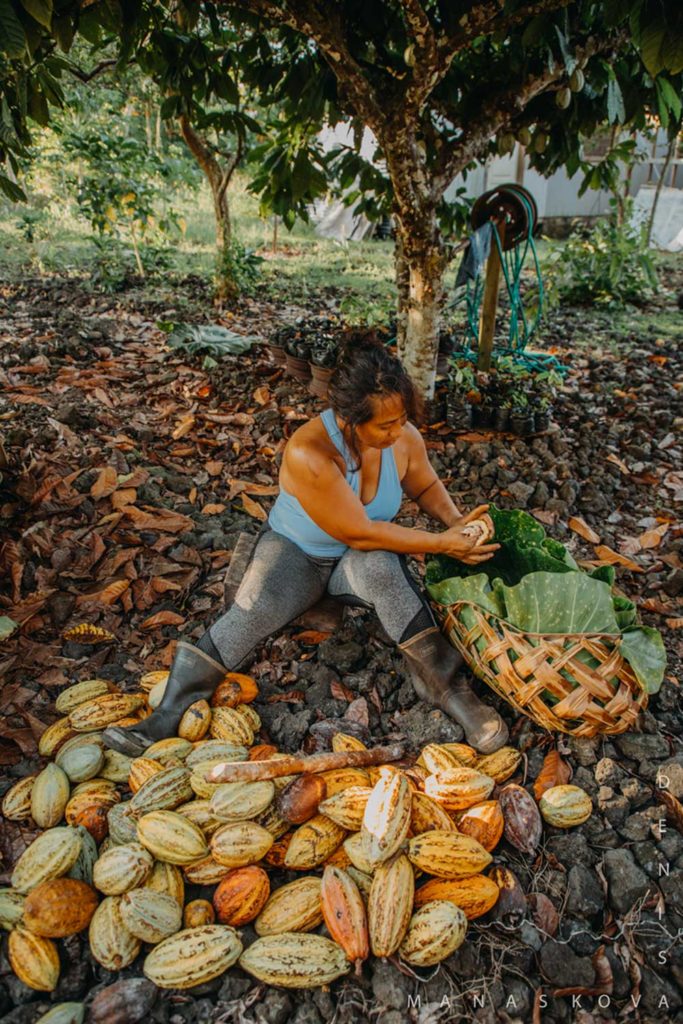Photographs by Denisa Manaskova
It’s early morning and Samoan cacao farmer and chocolate creator, Floris Niu, puts on her gumboots, ready for the day’s routine on her farm in Tuanai village, Samoa.
Her first task is part chore and part meditation as she heads to the umukuka or cookhouse shelter in her backyard. She lifts a banana leaf covering a large woven coconut leaf basket, revealing fermenting cacao beans.
As a former cacao bean supplier to boutique chocolate company “She Universe”, New Zealand, (where she also worked as a contract business development and marketing manager) Floris knows every bean she has exported or sold domestically.
As her hands turn the hot sticky beans, she explains;
“Although it looks very messy, the process is relaxing and I enjoy it. Fermenting develops the flavour of the bean by taking away the acidity that makes an unfermented bean taste strong and bitter. To make sure that the beans ferment equally, you have to turn or stir them to ensure they reach a fermentation temperature of close to 50 degrees celsius.”
During the peak periods of Samoa’s cacao exporting history in the 1900s, Samoan producers practiced fermentation but once the crop was no longer exported, it transitioned to becoming a part of Samoan daily life and these skills were lost over time because there was not the same need.
Fortunately a project that started in 2014 and supported by the Australian Centre for International Agriculture Research (ACIAR) has been helping to strengthen cacao production chains in the Pacific with a strong focus on reviving this forgotten skill.

Yan Diczbalis, who leads the project emphasised the need to bring back these practices to optimise cacao quality.
“Fermentation technology is crucial to the production of high quality cocoa and is the other issue we have supported in Samoa via Scientific Research Organisation of Samoa (SROS),” Diczbalis said. “Currently cocoa, when it is fermented, is box fermented. This is not a problem if done correctly, that is, the correct bean turning frequency and length of fermentation. Fermenting for longer than six days will produce off-flavours. We have supported SROS to examine the use of tray fermentation, which is to my mind a simpler method which requires no turning and has a set length of fermentation.”
Floris uses traditional technology passed down from her mother who taught her how to ferment cacao beans in woven baskets and turns her beans every 24 hours for up to five days.
“I learned this from when I was a kid,” she said. “My mother was taught this process by her mother and I will teach my daughter if she takes over the farm – people don’t do this process anymore. Samoans who make Koko Samoa today do not ferment the beans because they feel it is more aromatic if the beans are roasted straight from the cacao pod.”
During this method, a microbial cocktail of yeasts, lactic acid, and acetic acid bacteria in high temperatures of up to 50 degrees Celsius, dissolve the seed coat and kill the germ in the beans so they can no longer germinate. The cell walls are broken down, which means that different substances can react with each other and this is where the unique flavours are created.
“I describe my beans as mildly sweet, very fruity with very low acidity and a short earthiness,” says Floris. “It’s strong on the nose and has characteristics of the citrus and pineapples and sasalapa (soursop) growing around the trees.”

The flavours of the beans are further developed in the drying process where the moisture content of the beans is reduced from 60% to 7.5%. Most small holder farmers like Floris, spread the beans out in a single layer and sun dry for seven days in dry weather.
According to Floris, she knows when her beans are ready when they “crackle and sing” and feel light to pick up. She also does a cut-test of the beans to assess the colour, smell and how much the bean has shrunk during fermentation and drying.
Besides the advantage of originating from an exotic Pacific location with a rich cocoa history, Koko Samoa has another unique quality that is appealing to the specialty market – good genes.
“We have sampled in excess of 180 trees on Upolu and Savai’i and the great bulk, based on the parental attributions are Trinitario, which is a fine flavour cocoa type,” said Diczbalis. “Interesting the bulk of samples have a high Criollo content which may be an advantage in terms of flavour profiles.“
“I think Samoa has the genetics for fine cacao as well as being a wonderful origin for international buyers, “ said Diczbalis. “ If bean fermentation and drying are done properly and consistently then excellent quality beans are available for fine chocolate making domestically or internationally.”
Floris’s love affair with cacao has taken a new direction after six years of producing premium beans for craft chocolatiers in overseas markets. Floris has decided to focus on the local market and educate others to realise that cacao growers have everything in Samoa to create value added cocoa products like chocolate.
“In order for Samoa to develop fine flavoured chocolate in the future, farmers have to know their tree varieties, it’s bean flavour profiles, the importance of fermentation and drying the beans as well as practicing good roasting habits,” she says. “The technical knowledge must be accompanied by passion and patience, which are essential attributes to producing nutritious and delicious food.”
- This content is made possible with funding support from Australian Centre for International Agriculture Research (ACIAR)

Fine Mat Creative is a collective of freelance content creators






